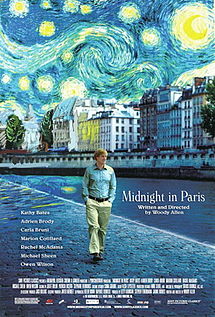 Recently I watched Woody Allen’s latest film “Midnight in Paris” in which the central character (Gil Pender), during his visit to Paris with his fiance’, manages to slip back in time to the Paris of the early 1920s. There Gil meets the greatest of the worlds literati during the period like F. Scott Fitzgerald, Ernest Hemingway, Gertrude Stein, Pablo Picasso, Salvador Dali and many others. Gil always thought that the 1920s was the golden age of literature and art and Paris was the center of this world. It was Gil’s dream come true. There in the 1920s Gil falls in love with the beautiful Adriana, Pablo Picasso’s lover. But to Adriana of the twenties, the golden age was “la Belle Epoque”, the European revival during the late 19th century. By a twist in the tale, Gil and Adriana travel back to the “belle Epoque” era to Maxim’s and meet Edward Degas, Toulouse Lautrec and Paul Gauguin, the great artists of the period. But when asked, these great artists say that to them the golden age was the period of Renaissance! Continue reading
Recently I watched Woody Allen’s latest film “Midnight in Paris” in which the central character (Gil Pender), during his visit to Paris with his fiance’, manages to slip back in time to the Paris of the early 1920s. There Gil meets the greatest of the worlds literati during the period like F. Scott Fitzgerald, Ernest Hemingway, Gertrude Stein, Pablo Picasso, Salvador Dali and many others. Gil always thought that the 1920s was the golden age of literature and art and Paris was the center of this world. It was Gil’s dream come true. There in the 1920s Gil falls in love with the beautiful Adriana, Pablo Picasso’s lover. But to Adriana of the twenties, the golden age was “la Belle Epoque”, the European revival during the late 19th century. By a twist in the tale, Gil and Adriana travel back to the “belle Epoque” era to Maxim’s and meet Edward Degas, Toulouse Lautrec and Paul Gauguin, the great artists of the period. But when asked, these great artists say that to them the golden age was the period of Renaissance! Continue reading
Category Archives: Generic
Atheism 2.0
Recently I watched this wonderful TED talk by Alain de Botton. He was talking about atheism, but unlike many other more radical atheists, he did not reject religion altogether. His philosophy is that, there is a class of people who do not really believe in the existence of god or gods, but they like the other aspects of religion like the rituals, the music, the literature, the art, the myths. Alain says that these aspects of religion, the more popular aspects which enrich us in many positive ways, we don’t have to reject them. I don’t want to go into the details of his talk, you can watch the video and listen for yourself, but this concept which Alain calls Atheism 2.0 rang a bell in me.
I love to attend our Durga Puja festivals, love to hear the mythological stories associated with Durga and Mahishasur although I don’t believe they really exist. I love to listen to the sonorous chanting of the “Chandi” or listen to the ecstatic Kirtan music and feel elated. I love Shyama Sangeet, I like to watch plays and listen to stories of Hindu mythology and the epics, although I don’t feel compelled to believe them as historical truth. And I believe, I am not alone. Many of us who have been sitting on the fence of religion, wondering which side to land on, now have this third option – Atheism 2.0. We refuse to be indoctrinated by religion, refuse to believe that ours is the best and for that matter any religion to be better than any other. But we gladly accept the goodies that these religions offers us and thus enrich ourselves with those aspects.
I would like to know what others think about this.
A Discourse on the Saree Fetish
By Amitava Sen
Why do we buy things?
Some for immediate consumption, like food, which we need for survival or mere delight of palate.
We buy theatre tickets, for enjoyment and entertainment.
Or, books and arts, to meet our intellectual needs.
We spend money on investment, with expectation for a return in cash or kind.
Also, for long term uses, like houses for shelter. The range of items like homes and cars are not always based on a minimum need; often times they exceed the rational limit. But their uses remain utilitarian nevertheless.
Amongst many others, clothing is an important area we spend our money on, so that we maintain a societal decorum and do not bare us to the world; and for sartorial splendor, of course.
Generally, we acquire thing to meet some kind of needs or perceived needs, material, physical or intellectual.
But there are a few items we get out of sheer obsession of the moments with complete disregard for need or return on investment and we make irrational judgment about the value of the acquisition. Consider for example, saree-buying frenzy of an India born women in our Bengalee community.
A mirror view is satisfying, but principally nice attire helps us look good in others’ eyes. At least that is a reasonable assumption. But observing some Bengalee women here, saree possession seems to have crossed the threshold of reasonableness; it looks like an uncontrollable mania. Continue reading
New Jersey Durga Puja 2011: A Personal Perspective
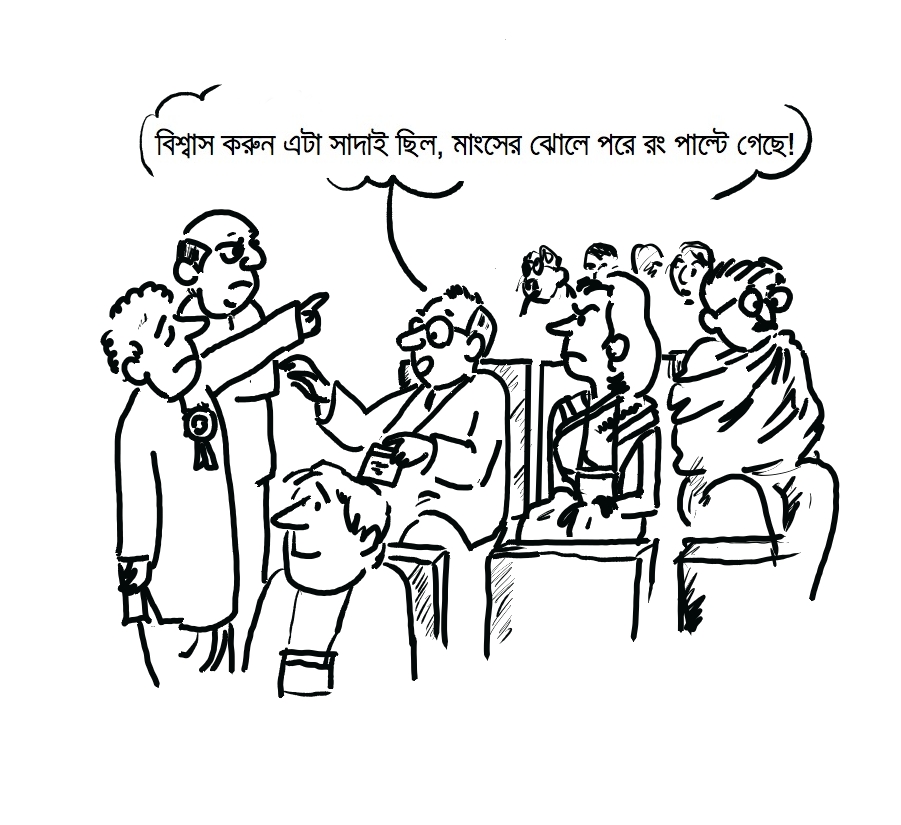 Yet another Durga Puja festival concluded with great pomp and fan fare. And each year we see the festival transforming itself in different ways. Some people hate change. They feel that tradition is something that should be protected with great care. Others feel, nothing should be cast in stone – rules and traditions should be broken to herald in fresh views and thoughts. I am okay with either school of thought, although I tend to lean towards the latter philosophy. Organizing an event like Durga Puja is not a trivial task, and not all things work according to plan. Besides it is not easy to satisfy everybody. However, I can speak about my experience and what I felt about the festival this year, especially the one celebrated by Kallol of New Jersey. Continue reading
Yet another Durga Puja festival concluded with great pomp and fan fare. And each year we see the festival transforming itself in different ways. Some people hate change. They feel that tradition is something that should be protected with great care. Others feel, nothing should be cast in stone – rules and traditions should be broken to herald in fresh views and thoughts. I am okay with either school of thought, although I tend to lean towards the latter philosophy. Organizing an event like Durga Puja is not a trivial task, and not all things work according to plan. Besides it is not easy to satisfy everybody. However, I can speak about my experience and what I felt about the festival this year, especially the one celebrated by Kallol of New Jersey. Continue reading
Durga Puja and Our Teenagers
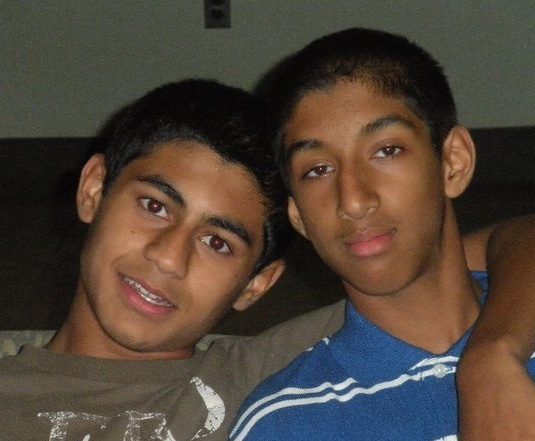 When we celebrate Durga Puja in this adopted homeland of ours, one thought keeps on playing in our minds – how much does our children enjoy this festival? Do they feel the same as we did when we were kids in our homeland? Many of us had the idea that our children really don’t care much about this favorite festival of ours. Often we have seen bored kids playing hand held video games in the hallways of our festival venue while their parents enjoyed inside. We sometimes debated, whether we are forcing our kids to come to the festival just because we want to, or it is our duty as a parent to introduce them to our culture and traditions? Is it working? Can they feel the spirit of the best festival of our community?
When we celebrate Durga Puja in this adopted homeland of ours, one thought keeps on playing in our minds – how much does our children enjoy this festival? Do they feel the same as we did when we were kids in our homeland? Many of us had the idea that our children really don’t care much about this favorite festival of ours. Often we have seen bored kids playing hand held video games in the hallways of our festival venue while their parents enjoyed inside. We sometimes debated, whether we are forcing our kids to come to the festival just because we want to, or it is our duty as a parent to introduce them to our culture and traditions? Is it working? Can they feel the spirit of the best festival of our community?
To get a more definitive answer, I asked my fourteen year old son Omkar and his friends a simple question. What does Durga Puja mean to them? And here are their responses. Continue reading
Durga Puja 2011 : New Jersey Style
It is said that you can take a Bengali out of Bengal, but you cannot take Bengal 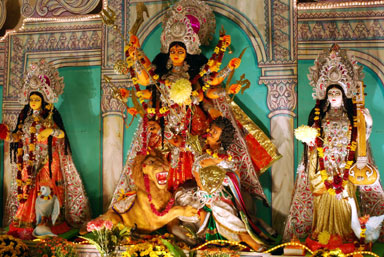 out of a Bengali. I’d rather rephrase it by saying that you can never take Durga Puja out of a Bengali. The greatest Bengali festival is once again knocking on our doors and the New Jersey Bengalis are gearing up to greet their Mother Durga with utmost fervor. Although according to the Bengali calender the puja starts (Maha Shasthi) on Sunday October 2, the enthusiastic New Jersey Bengalis are not willing to wait that long. ICC of Garden State will start their festival on Saturday 24th September and continue till Sunday the 25th. The Puja will be held at the Mt Olive High School, 18 Corey Rd, Flanders, NJ 07836. They have also lined up an impressive cultural program featuring the famous Bengali singer Nachiketa (more on Nachiketa later), a Bengali play from Toronto, and Soumen Adhikari, another singer from Kolkata. Several other local programs and great food also awaits the attendees. Note: I just learnt that ICC has canceled Nachiketa’s program due to lack of timely confirmation from the artist’s agent. Instead, they will be presenting Nirmalya Ray, a well known artist to the NJ music lovers. Continue reading
out of a Bengali. I’d rather rephrase it by saying that you can never take Durga Puja out of a Bengali. The greatest Bengali festival is once again knocking on our doors and the New Jersey Bengalis are gearing up to greet their Mother Durga with utmost fervor. Although according to the Bengali calender the puja starts (Maha Shasthi) on Sunday October 2, the enthusiastic New Jersey Bengalis are not willing to wait that long. ICC of Garden State will start their festival on Saturday 24th September and continue till Sunday the 25th. The Puja will be held at the Mt Olive High School, 18 Corey Rd, Flanders, NJ 07836. They have also lined up an impressive cultural program featuring the famous Bengali singer Nachiketa (more on Nachiketa later), a Bengali play from Toronto, and Soumen Adhikari, another singer from Kolkata. Several other local programs and great food also awaits the attendees. Note: I just learnt that ICC has canceled Nachiketa’s program due to lack of timely confirmation from the artist’s agent. Instead, they will be presenting Nirmalya Ray, a well known artist to the NJ music lovers. Continue reading
We All Have Names! Let’s Use Them!
We Bengalis have a special characteristic. We tend to setup familial relationships with almost any person we get acquainted with, especially when they are older than us. We cannot just address them by their names. We always want them to be our brothers, sisters, uncles, aunts, grandparents etc.
We do it with good intentions. We feel that it would be irreverent of us to address the middle aged gentleman we just met as “Arunabho” or “Satyen”. Addressing them by their first name is next to impossible. So we need to make a quick judgment call and decide what relationship we would like to establish with this new friend. Based on the looks, if the gentleman or lady seem to be close to our age, we try to make them our elder brother (Dada) or sister (Didi). If they seem to be middle aged, then “Kaku” or (Uncle) seems to be appropriate for men, and “Mashi” (Aunt) for women. For women, a subtle transition from “Mashi” to “Mashi-ma” can occur but one needs to be quite careful with that judgement. Often it so happens, that if it is a couple we meet, we call the husband “Kaku” (paternal uncle) and the wife “Mashi” (maternal aunt) – an almost absurd (although not impossible) relationship. When we meet a couple, “Kaku/Kakima” or “Mashima/Meshomoshai” is a better bet. It is odd though that the relations, “Mama” (maternal uncle) or “Pishi” (paternal aunt) are not used very often for such acquaintances. If you are ever doubtful about your social status in this relationship scale, I suggest you walk down the pavement in Gariahat Kolkata. The hawkers and roadside vendors will give you a perfect judgment about your age. Many ladies have experienced their development from “Didi” to “Boudi” to “Mashi” to Mashi-ma” to “Thakuma” from these experts. Continue reading
Learning About Our Heritage: A Task For The First Generation
by Amitava Sen
 A few years ago at the annual Durga Puja, the organizing club published a booklet for the benefit of the generation born and raised here, explaining the significance and meaning of the festival and its various events on different days. Rightly so, the narration started with Mahalaya, the new moon day preceding the Puja. Mahalaya is actually a day when Hindus, typically Bengali Hindus pay homage to the ancestors, culminating in Sharodiya Durga Puja six days later. Indeed, it is a Hindu practice to invoke the blessings of the ancestors before any solemn occasion, be it a wedding or an Annaprasan. But that was not what the author of the little booklet wrote in his explanation of Durga Puja for our children. Mahalaya, according to his narrative was the day on which Calcutta radio broadcast an audio musical, Mahishasurmardini. And that was all, what Mahalaya meant! Continue reading
A few years ago at the annual Durga Puja, the organizing club published a booklet for the benefit of the generation born and raised here, explaining the significance and meaning of the festival and its various events on different days. Rightly so, the narration started with Mahalaya, the new moon day preceding the Puja. Mahalaya is actually a day when Hindus, typically Bengali Hindus pay homage to the ancestors, culminating in Sharodiya Durga Puja six days later. Indeed, it is a Hindu practice to invoke the blessings of the ancestors before any solemn occasion, be it a wedding or an Annaprasan. But that was not what the author of the little booklet wrote in his explanation of Durga Puja for our children. Mahalaya, according to his narrative was the day on which Calcutta radio broadcast an audio musical, Mahishasurmardini. And that was all, what Mahalaya meant! Continue reading
Rajar Chithi : A Playwright’s Note
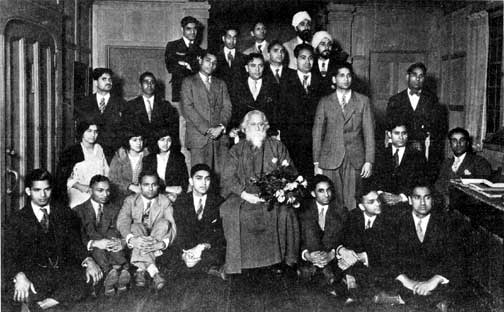 About a year and half ago, when I was researching on Rabindranath Tagore’s visits to the USA, an incident caught my attention. It said, that apparently there was an assassination attempt on Rabindranath by some Indians during his visit to San Francisco in October of 1916. This piece of information shocked me to say the least and I started to dig into the matter further. I looked into several books on Tagore by well regarded scholars and slowly an image started to take shape. I’ll refrain myself from getting into the details of the various accounts published in several books (you may look for them in the attached bibliography), but just to put matters in context I’ll quote some references: Continue reading
About a year and half ago, when I was researching on Rabindranath Tagore’s visits to the USA, an incident caught my attention. It said, that apparently there was an assassination attempt on Rabindranath by some Indians during his visit to San Francisco in October of 1916. This piece of information shocked me to say the least and I started to dig into the matter further. I looked into several books on Tagore by well regarded scholars and slowly an image started to take shape. I’ll refrain myself from getting into the details of the various accounts published in several books (you may look for them in the attached bibliography), but just to put matters in context I’ll quote some references: Continue reading Badal Sircar – The Maverick of Indian Theatre
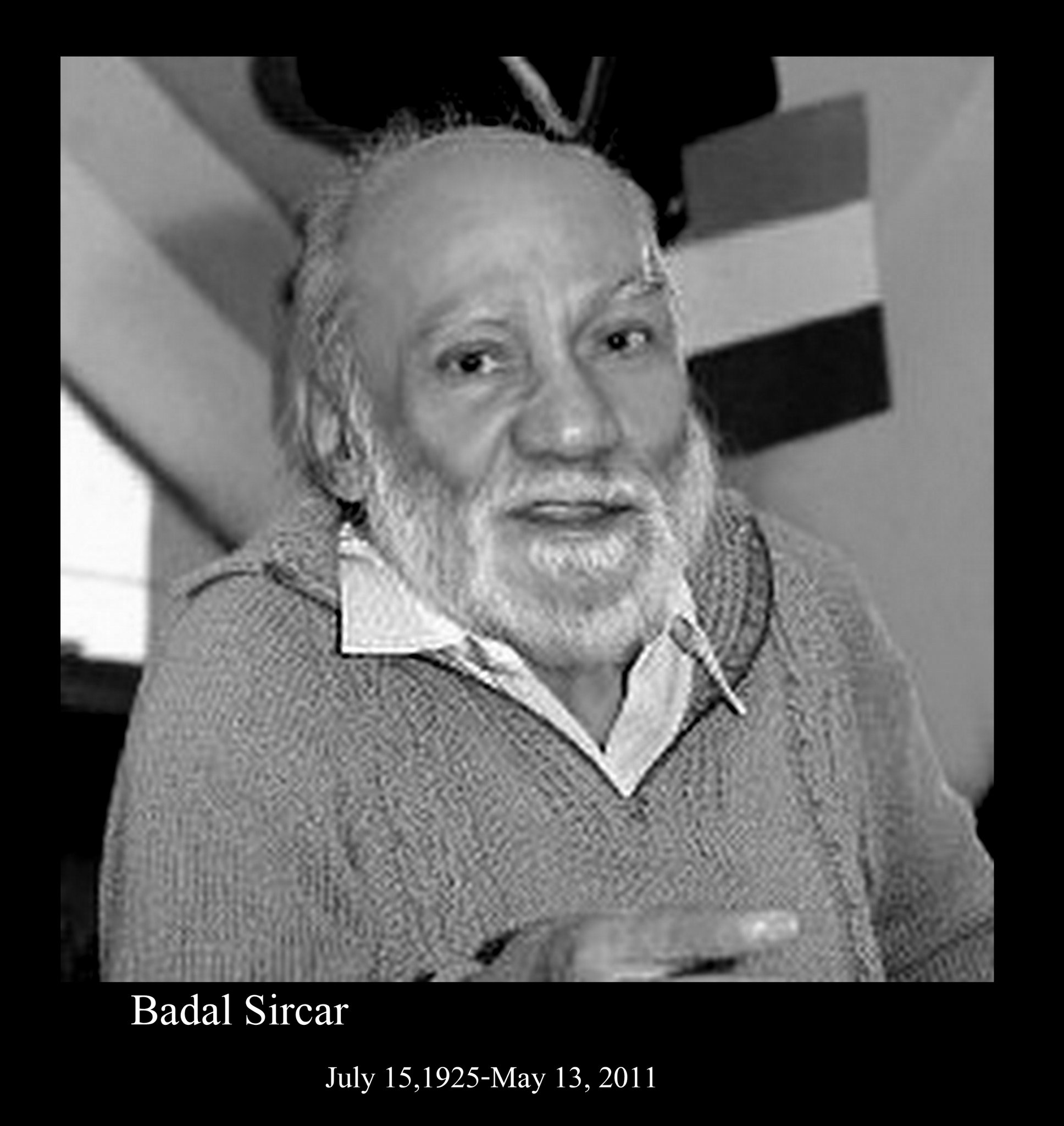 On 13th of May 2001, when the entire state of West Bengal was experiencing the euphoria of change, the landscape of Bengali theatre also changed forever. Badal Sircar, the maverick of Indian theatre, passed away almost unnoticed. But I am not going to write an obituary of Badal Sircar, neither I am going to write his biography. Rather I’d like to share with you my experiences with this theater personality through his work and from few of my personal interactions with him.
On 13th of May 2001, when the entire state of West Bengal was experiencing the euphoria of change, the landscape of Bengali theatre also changed forever. Badal Sircar, the maverick of Indian theatre, passed away almost unnoticed. But I am not going to write an obituary of Badal Sircar, neither I am going to write his biography. Rather I’d like to share with you my experiences with this theater personality through his work and from few of my personal interactions with him.
My first experience with Badal Sircar was when I was a child. In our campus (I grew up in IIT Kharagpur campus) the faculty, staff and students often staged plays and I think it was with “Boro Pishima” I first experienced theatre and it changed my life in many ways forever. Later I saw “Solution X” where my mother also participated in one of the lead characters. Few years later, when I was in high school, I went to see a student’s production (TDS _- Technology Dramatic Society) and was shaken to the core to see “Michhil” performed. It was an experience that I could never have expected. For the first time I realized that theater does not require a stage, does not require any expensive sets, any lights or any sophisticated sounds. All it needs are performers and an audience. And in most cases, the barrier between a performer and audience faded away – they became one whole theatrical entity. I also learned the term “Third Theatre”. The apparent simplicity of these production made me think, can theatre be so easy? My friends and I started to produce Badal Sircar, “Michhil”, “Bhoma” and others. We even started performing regular proscenium kind of plays in third theatre form. Continue reading
